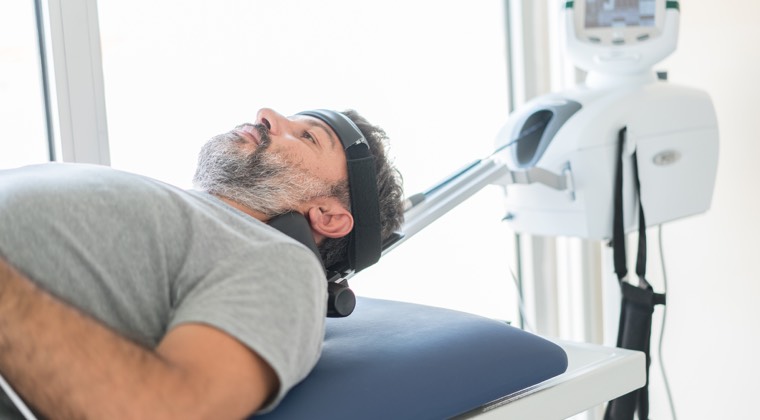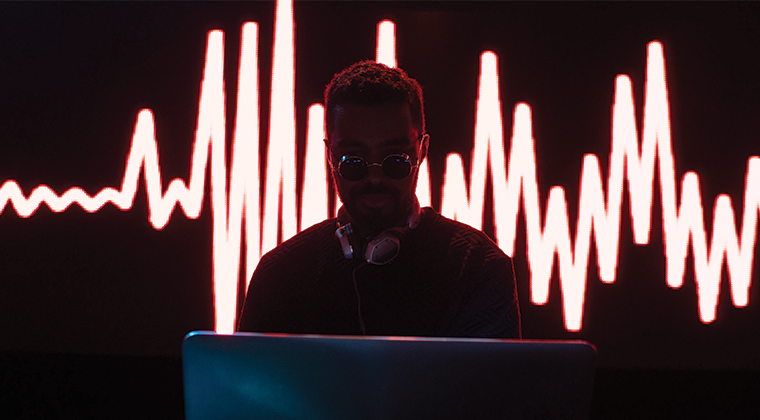There are several devices that reduce pain signals to the brain or alter how pain is processed and experienced. This section describes some of the more commonly used devices for pain management.
Braces
Back to topTreatment programs and braces will vary depending on the condition, type of injury, severity, and goals for the patient. Braces come in various types and sizes. A physical therapist will assist you in finding a brace that fits comfortably and helps the injury or condition.
Though bracing for chronic pain conditions is very limited, there are very specific instances in which it can be beneficial in very short episodes of use. Specialists will examine and evaluate your needs and also take into consideration your medical history and physical condition. After evaluation they will find a brace that fits your needs and abilities or they will have to design and fabricate one just for you. When wearing a brace, you should expect a reduction of muscle tension and pain, improvement in posture by redistributing weight, improvement in pressure points, better alignment for better healing, and increased function during activities. A brace is able to reduce range of motion during the healing process, reduce pressure on bony structures, and add stability to local joints.
Potential Risks
A brace might make a patient solely rely on the brace and cause muscles surrounding the joint to work less efficiently. Braces can be useful to remind patient to use muscles, but long-term use of braces is not advisable.
Resources: https://www.uofmhealth.org/conditions-treatments/rehabilitation/orthoses
Traction
Back to topTraction works by using decompression therapy to help relieve pressure on the spine. Spinal traction helps stretch the spine in order to help remove pressure from compressed discs. This helps straighten the spine and improves the ability for the body to heal itself. Traction can be administered mechanically or manually depending on your needs.
What to expect
In manual spinal traction, a physical therapist uses their hands to apply manual force on muscles and joints. In mechanical traction, you will lie on a table that stretches the spine. The table will have tools like slings and pulleys to help relieve pressure. This technique is performed for a small subset of individuals who meet evidence-based criteria, and is not widely successful for some forms of chronic pain.
Potential Risks
No long-term risks are known, but traction is known to cause short-term muscle spasms. Physical therapists should be prepared for this to occur during or after therapy.
Resources: https://www.uofmhealth.org/conditions-treatments/cmc/back-neck-and-spine-conditions/back-pain
Biofeedback
Back to topBiofeedback is a broad term describing the use of various devices that allow patients to receive information about how their body is responding to pain and stress. This feedback allows patients to practice effective ways for managing their body’s physical response. In the treatment of pain, biofeedback is often used to help promote physical relaxation. By being able to observe how the body responds, patients can learn and train themselves to relax more effectively. Biofeedback is often used in combination with specific skills such as diaphragmatic breathing, meditation, or other forms of relaxation. Biofeedback allows patients to receive direct feedback about whether what they are doing is having the intended effect. Biofeedback can also help patients be more aware of the connection between thinking patterns and how the body responds with stress or pain.
How does Biofeedback work?
Biofeedback typically involves being connected to a computer or some wearable device. These devices are used to measure one or more biological responses including breathing, heart rate, muscle tension, skin conductance (e.g. sweating), temperature, or brain wave activity. Changes in these physical responses have been shown to be related to pain, tension, and stress. A biofeedback device is used to monitor a patient’s physical response as they engage in new pain management skills and helps them to refine the use of their new skills. Biofeedback includes active participation by the patient, including both with and without a biofeedback device. The device allows patients to see in real time the effect of changes that they are making, but skills continue to require practice. Biofeedback is intended to be a short-term learning tool to help patients learn how to control different physiological processes in their bodies. Longer-term, patients are encouraged to practice these skills even when not using the device. One primary target for biofeedback is sympathetic nervous system arousal (fight or flight) which is active when in pain and can be effectively managed with practice, allowing patients to increase the ability to self-regulate their bodies response to painful experiences.
What other names might this go by?
As technology increases, multiple providers, devices, and agencies have started to market different forms of biofeedback. Traditional biofeedback is likely to be provided by a licensed medical professional and patients are encouraged to check a provider’s credentials before enrolling in treatment. Biofeedback may be performed as a component of another treatment such as interdisciplinary care, physical therapy or psychology.
There are now wearable devices, applications, and self-directed biofeedback devices on the market. While some of these treatments are effective, the FDA and State law does not regulate biofeedback devices or providers so interested patients need to ask questions about the level of professionalism associated with services being offered.
Neurofeedback is a specific type of biofeedback focused on brain wave activity. There are now businesses which provide neurofeedback services. Patients are encouraged to discuss treatment options and effectiveness with their current providers before engaging in this form of treatment.
What to expect
Biofeedback treatment can be provided in many ways. It often compliments another form of medical care such as psychology. Biofeedback-focused treatment may be performed briefly or for multiple sessions. When receiving biofeedback, a clinician will start by describing the procedure and the intended goals.
A device will then be connected to the patient in one or more ways. Common forms include attaching sensors to the fingertips, affixing sensors to problem muscle groups, use of respiration bands, or attaching temperature sensors. Biofeedback is a measurement tool and there should not be any discomfort associated with receiving biofeedback. In some cases (e.g. pelvic floor dysfunction) internally applied biofeedback devices may be appropriate. Biofeedback devices passively receive and monitor electrical signals coming from the body. Biofeedback does not put electrical signals back into the body.
Once connected, a patient will likely be provided with visual/auditory feedback on their performance. This feedback may be provided in many ways, most commonly through a computer screen which may include graphs, pictures, or even games. The provider will help the patient to identify specific targeted outcomes, which are often focused on increasing the relaxation response in the case of chronic pain treatment. Providers are likely to provide instruction on engaging in a specific skill (e.g. diaphragmatic breathing, progressive muscle relaxation), and then using the feedback provided to help the patient engage and refine each helpful skill.
Depending on the presenting issue and the patient’s response, the number and frequency of biofeedback sessions may vary. Patients will need to practice skills outside of treatment, often without the use of biofeedback devices. The ultimate goal of biofeedback is to assist in the development of self-management skills that can eventually be used by the patient without the biofeedback device.
Resources Applied Psychophysiology and Biofeedback website: https://www.aapb.org/i4a/pages/index.cfm?pageid=3463
Biofeedback Certification International Alliance – Find a Practitioner: https://certify.bcia.org/4dcgi/resctr/search.html
Psychology Today: https://www.psychologytoday.com/us/therapists/biofeedback
TENS (Transcutaneous Electrical Neuromuscular Stimulation)
Back to topTENS works through the delivery of small electrical impulses. These impulses start in the TENS unit (a small hand held machine), travel down electrodes, and into pads on the skin. These pads are specially designed to deliver the electrical impulse into the tissues and nervous system of the patient’s body. The nervous system picks up on these electrical impulses and sends signals to the brain which masks the sensation of pain from that area.
What to expect
When chronic pain is local and specific, the use of an electrical stimulator can be effective to dull the pain temporarily. Typically, this kind of modality is used after the intervention has proven to be helpful in the clinic, and is only used by the individual during very specific activities. You can expect to feel a strong tingling sensation under the pad which is attached to the skin. When successful, this tingling over-rides the pain sensations, and provides relief. The body is able to build a resistance to this TENS, so the longer it is used, the less effective it becomes.
Potential Risks
Patients with pacemakers should avoid this equipment because the electrical current could interfere with the pacemaker. There is a low occurrence of burns when the electrodes are not placed correctly, or the power is turned up too high.
Ultrasound
Back to topHow do ultrasounds work?
Ultrasound treatment involves the use of high-frequency sound waves to transfer heat into particular areas in the body. The ultrasound machine has a base unit that generates an electrical signal and a hand-held transducer. Ultrasound is used by physical therapists and occupational therapists for many different painful conditions. It is mostly used with people who have acute injuries or short-term pain. The deep heating increases blood flow with the goal of decreasing pain and inflammation. It can also be used to help muscles and tendons that are tight by increasing how much they are able to stretch.
What to expect
Your physical or occupational therapist will apply conductive gel to the treatment area. They will then move the ultrasound head back and forth to the treatment area. Depending on the condition, the therapist may adjust how much the waves will reach in the body. The treatment commonly lasts 5 to 10 minutes and is not performed more than once a day. During the treatment, there is no specific sensation noted within the tissue, only the feeling of the gel and the ultrasound head moving over the skin. Opinions vary on the effectiveness with chronic pain conditions.
Potential Risks
This treatment is considered to be safe when used therapeutically within rehabilitation. There are very rare side effects to its use in rehabilitation such as damage to tissues if used without adequate training.
Resources: https://www.uofmhealth.org/conditions-treatments/ultrasound







